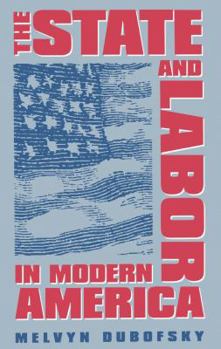The State and Labor in Modern America
Select Format
Select Condition 
Book Overview
In this important new book, Melvyn Dubofsky traces the relationship between the American labor movement and the federal government from the 1870s until the present. His is the only book to focus... This description may be from another edition of this product.
Format:Paperback
Language:English
ISBN:0807844365
ISBN13:9780807844366
Release Date:April 1994
Publisher:University of North Carolina Press
Length:342 Pages
Weight:1.20 lbs.
Dimensions:0.9" x 6.0" x 9.2"
Customer Reviews
2 ratings
Instructive overview of state regulation of labor unions
Published by Thriftbooks.com User , 16 years ago
This book gives an overview of the involvement of the U.S. government in labor relations from roughly 1877 through the Reagan years. The amount of primary sources in the book is impressive. I could think of a few labor related historical events that the author does not mention in this book but overall the detail and analyses are impressive and useful. He begins by describing federal government labor policy in the late 19th century. The U.S. was rapidly industrializing and economic competition was intense. The economy was in a continual state of booming and then falling into serious depression. Labor costs were the main target for businesses to slash in order to strengthen competitive position. When workers objected to wage cuts and bad conditions and organized to resist such measures, businesses usually had the backing of state and local authorities in crushing unionization and strikes. The courts were especially helpful to employers, granting injunctions against strikes on the ground that they interfered with interstate commerce. The courts made particular use of the Sherman Act of 1890 which was originally assumed to target corporate monopolies but judges used it against unions. Also, when federal troops were called out, they were placed under the control of state governments and used to crush unionization. One example Dubofsky gives is the use of federal troops by Idaho governor Frank Steunenberg in 1899 to arrest all union coal miners and release them only after they pledged not to return to the union. The federal troops also assisted state authorities in purging union sympathizers from local government posts. Dubofsky examines the evolving federal response to labor crises which constitutional traditions of the period usually placed in the hands of local and state authorities. After episodes of industrial unrest, Congress appointed investigatory commissions that condemned both management and workers and then did nothing more. Dubofsky places the 1894 Pullman strike as a time when one began to hear the beginnings of federal government endorsement of "responsible unionism." But it was not until Theodore Roosevelt when a president gave a substantial amount of rhetorical support to responsible unionism. In this case the responsible unions were the relatively well paid and work secure craft unionists of the American Federation of Labor. In contrast, his hostility to the IWW was quite extreme, similar to that held by other leading politicians in the period. He refused pleas of the Western Federation of Miners, from which the IWW sprung, to protect them in Colorado from the extensive violations in 1903-05 of their civil liberties. In the face of a reactionary judiciary, business and congress, he did little to push for the legislative demands of the A.F of L. He did instruct federal troops sent to Nevada to keep order during an IWW coal strike not to aid in suppressing the strike, which ended up crushed by the companies and local authoritie
A Revisionist look at the Tripartite Relationship
Published by Thriftbooks.com User , 24 years ago
In a revisionist look at labor history in the 20th century, Melvyn Dubofsky counters the typical claim that government has played a repressive role in government-union-capital relationships. His argument, not accepted by many labor scholars, is that labor benefitted in the long-run through the states intervention -- atempting to diffuse the potential revolutionary zeal of the masses by appeasing them with small gains.Dubofsky's methodology launches a liberal attack on Marxist thinkers and activists by challenging the view that government is a tool of capital to hold workers in check. His work points out that unions gained when the people organized and threatened militantcy. Government sought to appease labor through putting pressure on capital. However, when labor crossed the line actually becoming militant and acting out against the states authority, government sided with capital -- an action more in line with providing the economic stability everyone needs.Labor history in a raw sense is both shocking and appalling. His account of labor history is packed with detail, and historical accounts which sometimes get in the way of his thesis.





